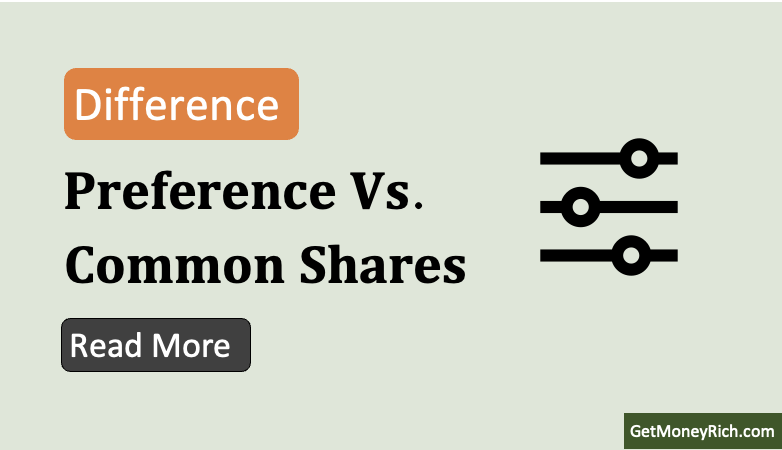Common stocks represent ownership in a company and offer voting rights. They also have a potential for long-term growth and variable dividends. Preferred stocks have a higher claim on assets and dividends, but typically lack voting rights. Understanding the differences between common vs. preference shares can help us pick the right one based on our long-term goals.
Stocks are a fundamental component of investing representing ownership in companies. They offer a potential pathway to long-term wealth creation. They allow individuals like me and you to participate in the growth and profits of businesses. A business that is growing will also pull its stock price with itself. Generally, good businesses can grow fast. Hence, for a person whose objective is long-term wealth building, stock becomes an essential ingredient of a diversified investment portfolio.
When it comes to stocks, there are two main types, common and preferred stocks. Common stocks represent ownership and voting rights. Preferred stocks have a higher claim on assets and dividends.
Understanding the differences between the two is necessary. Without this knowledge, we may miss out on potential gains or expose ourselves to unknown risks.
In this article, we’ll delve into the details of Common vs. preference shares. We’ll explore their unique characteristics, advantages, and disadvantages.
Topics:
1. Difference Between Common and Preferred Stocks
Suppose there are two shareholders of a company (Tata Steel). One is a preference shareholder and the other is a common shareholder. What are the differences in experiences between the preference shareholder and the common shareholder?
- Preference shareholders receive fixed and regular dividend payments. Yield can typically range between 2-3% of the face value. They have a higher claim on assets and dividends compared to common shareholders. However, they cannot participate in the company’s growth or profits beyond the fixed dividend payments.
- In contrast, common shareholders participate in the company’s growth and profits through potential capital appreciation. They receive variable dividend payments and have voting rights.
For instance, Tata Steel’s stock price increased by over 9.2 times (12.34% CAGR) in the last 20 years, significantly benefiting common shareholders. People who remained as a preference shareholder of Tata Steel during this period would not have enjoyed this capital appreciation
Here’s a table highlighting the key differences between preference and common shares:

| Description | Preference Shares | Common Shares |
| Dividend Payments | Fixed | Variable |
| Capital Appreciation | No | Yes |
| Voting Rights | No | Yes |
| Share Price | Fixed | Volatile |
| Possibility of Long Term Wealth building? | No | Yes (Fast Growth) |
| Stable Income? | Yes (But not like bonds) | No |
2. Face Value of Common vs. Preference Shares – The Difference
The face value of a preference share is typically fixed and stated on the share certificate. However, the face value of a common share is usually nominal (e.g., Re 1 or Rs 10) and not representative of its market value.
Preference shares have a fixed face value. It is also known as the par value or nominal value. The face value of preference shares is the amount that the company promises to pay back to the shareholder when the shares are redeemed or converted. This face value is usually higher than that of common shares.
For example, a preference share might have a face value of Rs 100, while a common share might have a face value of Re 1. This means that the preference shareholder is entitled to receive Rs 100 per share if the shareholder redeems his/her shares. At the same time, the common shareholder has no such guarantee.
The face value of a preference share is a fixed amount. It represents the company’s commitment to pay back the shareholders. Whereas the face value of a common share is largely symbolic and does not reflect its market value.
3. How to Buy Preference Shares
Let’s say you’re an investor in India looking to buy shares in an example company called “ABC Ltd.”
You have the option to buy either preference shares or common shares.
Here’s how you can buy preference shares:
- Step 1: Check if ABC Ltd. has issued preference shares. You can check the company’s website, and financial reports, or consult a stockbroker to check this fact.
- Step 2: Determine the issue price. Find out the issue price of the preference shares. It is the price at which the company is offering the shares to investors. Let’s say the issue price is Rs 100 per share.
- Step 3: Decide on the quantity, and how many preference shares you want to buy. Keep in mind your investment budget.
- Step 4: Buy through an online platform. You can buy preference shares through a stockbroker or online platforms like Zerodha, Upstox, or ICICI Direct. You’ll need a Demat account and an online trading account.
- Step 5: Receive the shares. Once the transaction is complete, the preference shares will be credited to your demat account.
Example: ABC Ltd. issues 10,000 preference shares at Rs 100 each. You buy 100 shares, investing Rs 10,000. If the company declares a 5% dividend, you’ll receive Rs 500 (5% of Rs 10,000) as dividend payout. Remember, you will buy preference shares for stable and fixed returns.
Note: Preference shares trade in the secondary market, just like common shares. However, their liquidity is typically lower compared to common shares. For example: Suppose Reliance issued preference shares with a face value of ₹100 each. These preference shares will be listed on NSE/BSE like RIL’s common stocks. Investors can also sell these preference shares at their prevailing market price, just like common shares. It is essential to note that the trading volumes of preference shares remain very low.
3.1 Significance of Face Value in Preference Shares Purchase
When we buy preference shares, we pay the issue price. It is the price set by the company for the shares. However, the face value of the preference shares is the amount that the company promises to pay us back when the shares are redeemed or converted.
For example, let’s say we bought 100 preference shares of ABC Ltd. with a face value of Rs 100 each and an issue price of Rs 120 each. Hence, we paid Rs 12,000 (100 shares x Rs 120) for the shares.
The company promises to pay us back Rs 10,000 (100 shares x Rs 100 face value) when the shares are redeemed or converted.
So till now, we’ve invested Rs.12,000 and we are assured a redemption amount of Rs.10,000. Moreover, during the holding period, the preference shares will also pay dividends.
The face value is significant because it represents the minimum amount that the company guarantees to pay back to us.
In this example, we paid a premium of Rs 20 (Rs 120 – Rs 100) per share, which is the difference between the issue price and the face value.
4. How To Buy Preference Shares Below Its Face Value
It is possible to buy preference shares at a market price below their face value. This can happen in the following rate scenarios:
- Rising Interest Rate Scenario: When interest rates rise the demand for existing preferred shares with lower yields decreases. This can cause their market price to fall below their face value.
- Problems with the Issuer: When the creditworthiness of the issuing company deteriorates, investors may become less willing to hold the preferred shares. This can drive the market price down.
- Volatile Market: In times of economic downturn, investors may sell their preferred shares at a discount, below their face value.
An example is the market price of the preferred shares of Vodafone Idea Ltd. (VIL) in India. In May 2022, the market price of VIL’s preference shares with a face value of ₹100 was trading at around ₹70-₹80. This was due to the company’s financial struggles and the telecom industry’s challenges.
Investors could have bought these preference shares at a discount to their face value. But it is also important to note that this investment would come with higher risks.
Conclusion
There is a difference between common and preference shares. This article highlights their unique characteristics, advantages, and disadvantages. Preference shares offer fixed dividend payments, priority over assets, and dividends. However, it lacks voting rights and potential for long-term growth.
Common shares, on the other hand, represent ownership and voting rights. though it offers variable and inconsistent dividend payments, it offers a potential for capital appreciation.
The face value of preference shares is fixed and higher than that of common shares. Investors can buy preference shares through a stockbroker or online platforms.
It is possible to purchase them below their face value in certain market scenarios, such as rising interest rates or issuer creditworthiness issues.
Frequently Asked Question
No, while preference shares offer a fixed dividend rate, the actual return may vary depending on the company’s performance and market conditions. If a company is unable to pay the dividends it decides to pay none or lower dividends (even to a preference shareholder).
Yes. If a company’s performance is poor, it may choose to pay lower or no dividends to preference shareholders. Dividend payments are discretionary and dependent on the company’s profits.
Sometimes, preference shares may be convertible into common shares. But this depends on the specific terms and conditions of the issue.
Not necessarily. While preference shares offer a fixed return, they may carry credit risk if the issuer defaults. There is also a market risk if interest rates change.
No, the market price of preference shares can fluctuate. Investors may buy or sell them at a price different from the face value or issue price.
Have a happy investing.






